
By Jeffrey Drazen - University of Hawaiii at Manoa
July 6, 2016
This cusk eel is a great demonstration of a slow anguilliform swimming in a deep-sea fish. Video courtesy of NOAA Office of Ocean Exploration and Research, 2016 Deepwater Exploration of the Marianas. Download (mp4, 24.0 MB).
As we explore the deep sea around the Mariana Trench, we are documenting a number of fish, some potential new species, some extensions of their previously known ranges, and some are just exciting and beautiful fauna to see.
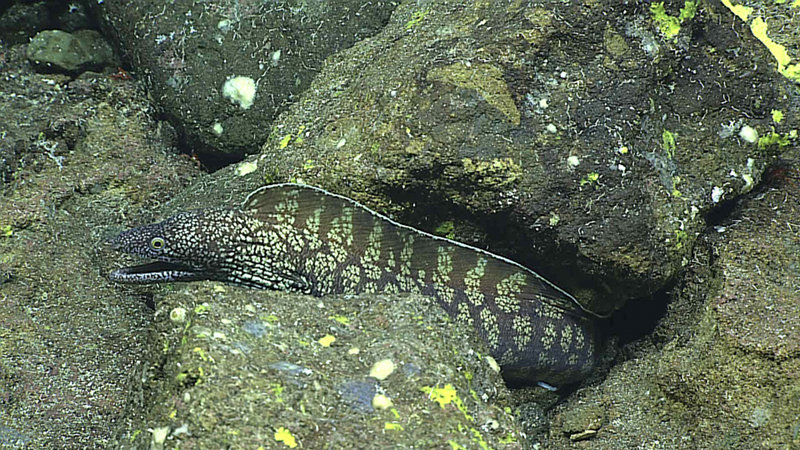
Shallower living moray eels like this one seen at a depth of 279 meters on Dive 6 at Supply Reef on June 23, 2016, are nocturnal and/or live in holes and crevices to avoid predators. Image courtesy of NOAA Office of Ocean Exploration and Research, 2016 Deepwater Exploration of the Marianas. Download larger version (jpg, 1.4 MB).
In the deep sea, we see many cutthroat eels, cusk eels, halosaurs, and codlings with long, tapering body shapes. Fish with oval or torpedo-shaped bodies, like that of a tuna or a grouper, are rare at depths greater than half a mile down. There are distinct advantages that have led to the prevalence of the long body type that help us answer the question of why is this type of fish so common in the deep sea.
Fish in shallower waters, such as these fish seen near the surface shortly after launch of the remotely operated vehicle, swim by rapidly wagging their tails. Video courtesy of NOAA Office of Ocean Exploration and Research, 2016 Deepwater Exploration of the Marianas. Download (mp4, 9.0 MB).
The characteristic slow undulations of anguilliform swimming (with anguilla referring to eels) is made possible by an elongate, tapering body with many vertebrae. The undulating motion uses less energy than the typical, fast, tail-wagging motion of many shallow-water fishes, called carangiform swimming (with carangi referring to jacks or trevallies). Some shallow-water fishes also swim by flapping the fins on either side of the body behind the head (labriform swimming, with labri referring to wrasses) or wagging the dorsal and anal fins (tetraodontiform swimming, with tetraodonti referring to puffers). Of those types of swimming, it is thought that anguilliform swimming uses the least energy, which is useful in deepwater environments where food is less available than in shallow waters.
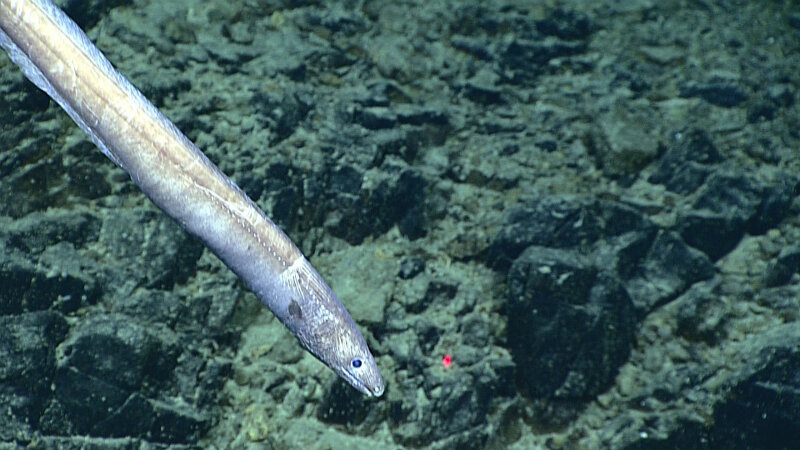
Deeper-living eels like this cutthroat eel, Synaphobranchus sp., are abundant in the deep ocean and are active day and night in the open. This eel was seen on Dive 10 at 3,145 meters at Stegasaurus Ridge on June 27, 2016. Image courtesy of NOAA Office of Ocean Exploration and Research, 2016 Deepwater Exploration of the Marianas. Download larger version (jpg, 824 KB).
Anguilliform swimming also allows fishes to back up quickly or make U-turns when they encounter food or predators in the deep-sea environment.
Disadvantages are that anguilliform swimming doesn't allow the full range of maneuverability given by labriform or tetraodontiform swmming, or the rapid swimming allowed by carangiform swimming. Luckily, fishes don’t have to be very fast in the deep sea. The strong selective pressure to be fast is greatly reduced because long chases and evasions don’t happen or happen much less often. There simply isn’t enough light to allow them to be effective – you can’t chase something far if you can’t see it farther away than a meter.
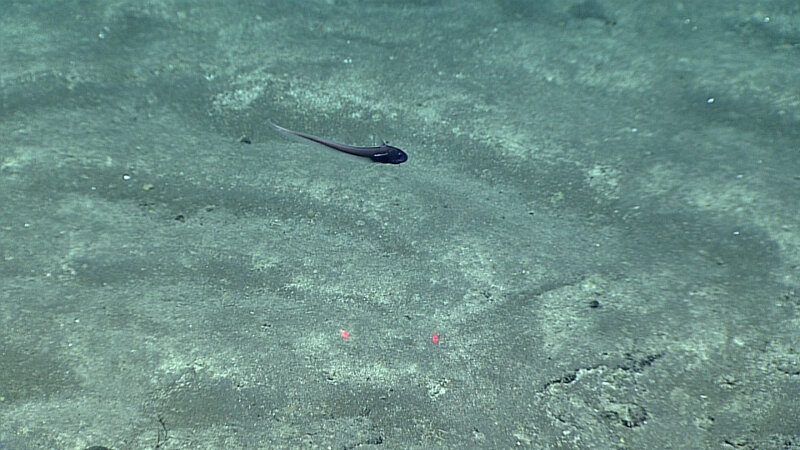
Macrourids like this one are an incredibly common and diverse family of deep-sea fish with more than 200 species. They have a long, tapering tail that got them the nickname “rattail,” though due to commercial fishing, they have been renamed “grenadiers.” This rattail was seen on Dive 14 at Explorer Ridge Deep at a depth of 2,228 meters on July 1, 2016. Image courtesy of NOAA Office of Ocean Exploration and Research, 2016 Deepwater Exploration of the Marianas. Download larger version (jpg, 827 MB).
The lack of selection for fast and maneuverable body forms in the deep ocean then results in all sorts of elongate body forms and even globular fishes like blobfish and anglerfishes. Fish of these forms would be gobbled up in no time in brightly lit surface waters. This is also why most eel-like fishes in shallow waters hide in crevices or only come out a night. Elongate bodies and anguilliform swimming are really efficient, so you see their prevalence where the fishes can get away with it – in the dark, deep ocean.
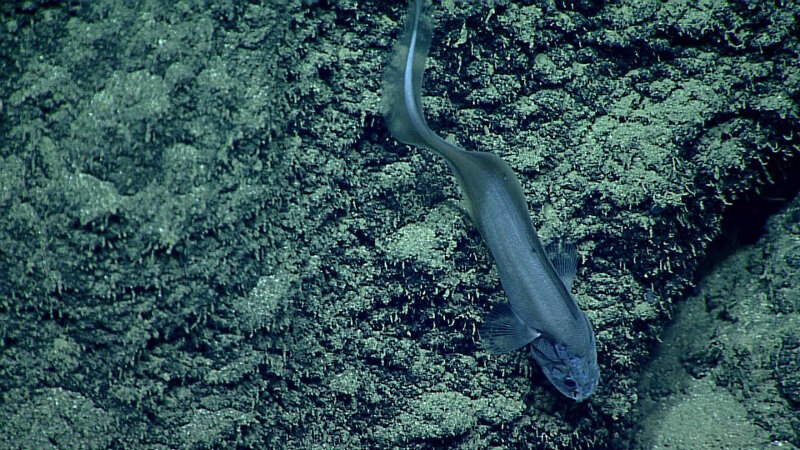
Cusk eels, like this Leucicoris, are another incredibly diverse and common family of deep-sea fishes that have long, tapering, eel-like tails. We have seen various species throughout the Marianas Trench Marine National Monument, where they are very common from about 1,000 meters to depths of nearly 6,000 meters. This particular fish was seen at Explorer Ridge Shallow on Dive 15 at a depth of 1,607 meters on July 2, 2016. Image courtesy of NOAA Office of Ocean Exploration and Research, 2016 Deepwater Exploration of the Marianas. Download larger version (jpg, 1.3 MB).
Another reason is that the elongate, slowly undulating body allows for increased development of the lateral-line system, the vibration and pressure sensing organs along the side of the body. In the lightless environment of the deep sea, senses other than vision become very important. Increased ability to sense vibrations and pressure waves, including eddies created by other swimming organisms, is an advantage for detecting predators and finding food in the dark, deep ocean. An elongate body not only increases the length of the lateral line, but anguilliform motion reduces the turbulent flow of water along a fish’s body that happens with carangiform or labriform swimming, providing the fish with a heightened ability over their non-elongate relatives.
A benefit of anguilliform swimming is that with a long fin along the bottom edge of the body and a tilted body angle with the head downward, this method of swimming can create a downward thrust for the fish. We see many rattails and cusk eels with that orientation. Deep-sea fishes that live near the bottom usually feed on bottom-dwelling prey like worms, squat lobsters, shrimp, amphipods, and little fish, among other things. A swimming mode that allows fish to cruise slowly along the bottom with the head down and tail up assists in feeding and predator sensing.
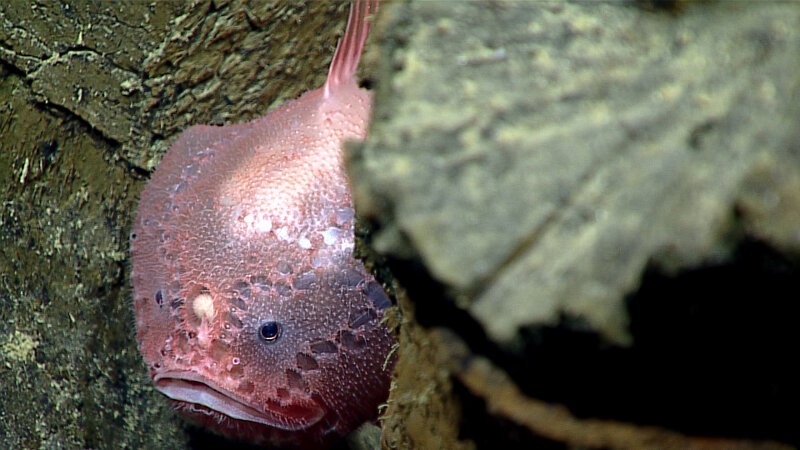
A deep-sea anglerfish living within the pillow basalts. You can see its round lure in between its two eyes. This fish, with its blob-like body, is an ambush predator that waits for prey to be attracted by the lure before rapidly capturing them in one gulp with their large mouths. Image courtesy of NOAA Office of Ocean Exploration and Research, 2016 Deepwater Exploration of the Marianas. Download larger version (jpg, 1.1 MB).
As you can see, there are several reasons that the fish groups that have been most successful in colonizing the deep ocean are often anguilliform swimmers with elongate bodies - even in their related shallow-water species (e.g., eels, cusk eels). In those cases, the elongate bodies are evolutionarily persisting features that were advantageous for deep-sea life. The groups of shallow-water fishes with elongate bodies were "pre-adapted" for colonization of the deep sea, where the newly evolved deep-sea species with elongate bodies and associated swimming mode could become very successful and also acquire habits of swimming in the open.